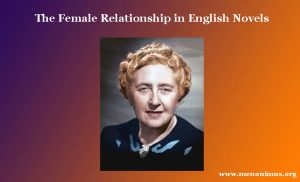The Female Relationship in English Novels
The Female Relationship in English Novels
The Female Relationship in English Novels
Introduction
The portrayal of female relationships in English novels has evolved significantly over the centuries. From the early works of Jane Austen and the Brontë sisters to contemporary literature, the representation of female bonds has undergone transformation, reflecting changes in societal attitudes, gender dynamics, and the role of women in society. This essay explores the depiction of female relationships in English novels, examining their historical development, the evolving dynamics, and their significance in the broader context of literature and society. The Female Relationship in English Novels
Historical Perspectives
In the 18th and 19th centuries, the portrayal of female relationships in English novels often revolved around family and sisterhood. Novels like Jane Austen’s “Pride and Prejudice” and the Brontë sisters’ works, such as “Jane Eyre” and “Wuthering Heights,” focused on the complexities of sisterly bonds and familial connections. These novels often highlighted the supportive but occasionally competitive relationships between sisters and female relatives, demonstrating the limited opportunities for women to form relationships outside of the family unit. The Female Relationship in English Novels
The Role of Female Friendship
As literature progressed into the 19th and early 20th centuries, female friendships began to play a more significant role in English novels. Authors like Virginia Woolf, in her novel “Mrs. Dalloway,” and E.M. Forster, in “A Room with a View,” explored the friendships and camaraderie among women. These novels showcased the emerging independence of women and their growing social circles beyond the confines of their families.
Female friendships provided a space for emotional support, self-discovery, and mutual empowerment. These relationships allowed women to share their experiences, frustrations, and aspirations, making them an essential component of female characters’ personal growth and the novels’ overarching themes. The Female Relationship in English Novels
Challenging Gender Norms
In the mid-20th century, with the advent of feminism and the feminist literary movement, English novels began to challenge traditional gender roles and heteronormative relationships. Authors like Doris Lessing and Margaret Atwood explored complex female relationships that defied societal expectations.
Lessing’s “The Golden Notebook” and Atwood’s “The Handmaid’s Tale” presented dystopian settings where women’s relationships with one another became crucial for their survival and resistance against oppressive patriarchal regimes. These novels highlighted the strength of female bonds in the face of adversity and the importance of women supporting one another. The Female Relationship in English Novels
Contemporary Narratives
In contemporary English literature, the representation of female relationships continues to evolve. Female friendships, both platonic and romantic, are portrayed with more complexity and diversity. Novels like Zadie Smith’s “Swing Time” and Sally Rooney’s “Normal People” explore the intricate dynamics of modern female relationships in a world marked by increasing social, cultural, and technological changes.
In these contemporary novels, female relationships are not limited to sisterhood or friendship but also encompass themes of love, desire, and intimacy. The exploration of female sexuality and the fluidity of relationships reflect the evolving discussions around gender and sexuality in society. The Female Relationship in English Novels
Significance in Literature and Society
The portrayal of female relationships in English novels holds significant cultural and societal importance. These depictions not only reflect changing societal norms but also contribute to the shaping of public perception. They provide readers with insight into the experiences, challenges, and triumphs of women, allowing for greater empathy and understanding of female experiences.
Furthermore, these novels have played a role in inspiring real-world changes. By showcasing the strength, resilience, and support within female relationships, literature has been a source of empowerment for women. It has encouraged them to forge their own paths, challenge oppressive norms, and build supportive communities.
Conclusion
The representation of female relationships in English novels has come a long way from the early 19th century to the contemporary era. These relationships have evolved from primarily familial and sisterly bonds to encompass a broader spectrum of friendships, love, and solidarity among women. The significance of these portrayals in literature and society cannot be understated, as they reflect the evolving roles and rights of women and contribute to a more inclusive and empathetic society. English novels continue to be a platform for exploring the complexities of female relationships, showcasing the strength and resilience of women in their various forms. 0 0 0. The Female Relationship in English Novels
The Female Relationship in English Novels
You May Like:
Additional Searches:











